Physical Address
304 North Cardinal St.
Dorchester Center, MA 02124
The skin has a primary protective function, providing a permeability barrier that prevents the loss of water and electrolytes and protects against the invasion of pathogens. Intact skin is resistant to colonization and invasion of bacteria by several mechanisms.
The outermost layer of the epidermis, the stratum corneum, constitutes the principal barrier against infection. The stratum corneum consists of corneocytes (i.e., anucleated keratinocytes or skin cells) and an outer lipid matrix. Corneocytes fit together in an overlapping fashion, making penetration by organisms difficult. Because they are shed from the skin after approximately 14 days, pathogenic organisms have limited time to invade further into the epidermis. The lipid matrix surrounding corneocytes is acidic, providing antimicrobial activity against pathogenic organisms, including Staphylococcus aureus and Streptococcus pyogenes . ,
Keratinocytes also participate in innate immunity by secretion of antimicrobial peptides (AMPs) such as human β-defensins, cathelicidin, psoriasin, and dermcidin. AMPs are small peptides with broad-spectrum antimicrobial activity against bacteria, viruses, and yeast. , Production of AMPs by keratinocytes is stimulated by inflammatory cytokines produced in the skin as a result of injury or inflammation and by invasive organisms through pathogen-associated molecular patterns (PAMPs). Resident bacteria on the skin provide additional protection against infection by preventing colonization with pathogenic organisms through competitive binding to cell surface receptors and by the production of toxic substances called bacteriocins that inhibit the growth of similar bacteria. , ,
Skin microflora can be categorized as two groups: resident flora and transient flora. Resident flora establish secure attachments to the skin, are present in stable numbers, and can tolerate an acidic environment. Transient flora are introduced from the environment and attach only if the skin is disrupted. , S. pyogenes and S. aureus are the most common transient bacteria on the skin that cause infection. ,
Various bacteria are considered to be normal resident flora, and each organism has a predilection for specific anatomic locations and for hosts of a particular age. , , The skin becomes colonized with microorganisms during the birth process and through contact with the environment. Infants born vaginally acquire Staphylococcus epidermidis during passage through the vaginal canal, and within hours, coryneform bacteria are found on neonatal skin. The dry surface of the stratum corneum is colonized by micrococci and coagulase-negative staphylococci (CoNS), , whereas coryneform organisms and gram-negative bacilli prefer moist, intertriginous areas. , , , Cutibacterium spp. grow in hair follicles and sebaceous glands and are mainly found after puberty, when sebaceous activity increases. , , Hair follicles are colonized by micrococci and CoNS superficially ; Corynebacterium and Cutibacterium spp. are found deep in follicular canals. ,
Transient colonization of the skin by pathogens is facilitated by factors that harm the resident flora, including elevated temperature, humidity, and antibiotic therapy. , When a pathogen achieves successful colonization of the skin, the other cutaneous defense mechanisms must be overcome before infection commences. The main determinant of cutaneous infection is the balance between the virulence of the organism and the defense mechanisms of the host. Compromised cutaneous barrier function occurs in patients with chronic dermatitis or injury and in premature infants, making their skin more susceptible to pathogenic colonization and cutaneous infection.
Primary bacterial infection of the skin can involve the epidermis, dermis, or subcutaneous tissue, whereas soft tissue infections extend deeper to the fascia or muscle. Superficial skin infections are mainly limited to the epidermis and dermis, although secondary inflammation can involve the subcutis. Several types of lesions can form in the skin as the result of a primary infectious process ( Table 67.1 ), but a pathogen usually produces a characteristic primary lesion with a characteristic pattern of spread. When cutaneous bacterial infection occurs, recognition of the type and depth of lesion produced are helpful in determining the likely causative agent.
| Lesion | Description |
|---|---|
| Macule | Flat lesion <1 cm |
| Patch | Flat lesion >1 cm |
| Papule | Elevated lesion <1 cm |
| Plaque | Elevated, broad, flat lesion >1 cm |
| Nodule | Dome-shaped or rounded lesion >1 cm Arises from the dermis or subcutis |
| Pustule | Pus-filled lesion |
| Vesicle | Elevated lesion <1 cm Filled with serous fluid |
| Bulla | Elevated lesion >1 cm Filled with serous fluid |
Primary, superficial bacterial infections of the skin and cellulitis are the focus of this chapter ( Table 67.2 ). Other infectious agents (e.g., viruses, fungi) that sometimes resemble these bacterial infections are discussed briefly.
| Disease | Skin Lesions/Findings | Infectious Agents |
|---|---|---|
| Anthrax | Papule, vesicle, bulla | Bacillus anthracis |
| Blistering distal dactylitis | Vesicle, small bulla | Streptococcus pyogenes (group A Streptococcus ), Streptococcus agalactiae (group B Streptococcus ), Staphylococcus aureus |
| Cellulitis | Poorly defined erythema/edema/induration | S. pyogenes, S. aureus |
| Diphtheria | Papule, pustule, ulcer | Corynebacterium diphtheriae |
| Ecthyma | Pustule, ulcer | S. pyogenes |
| Ecthyma gangrenosum | Papule, vesicle, ulcer, black eschar | Pseudomonas aeruginosa , other gram-negative bacilli ( Klebsiella spp.) |
| Erysipelas | Plaque, sometimes vesicles or bullae | S. pyogenes, groups B, C, and G streptococci |
| Erysipeloid | Patch, plaque | Erysipelothrix rhusiopathiae |
| Folliculitis | Perifollicular pustules, papules | S. aureus, Malassezia spp. |
| Sycosis barbae | Pustule, papule | S. aureus |
| Gram-negative folliculitis | Pustule, papule | Klebsiella spp., Enterobacter spp., Escherichia coli, P. aeruginosa |
| Pustule, nodule | Proteus spp. | |
| Hot-tub folliculitis | Pustule, papule | P. aeruginosa |
| Erythrasma | Patch | Corynebacterium minutissimum |
| Furuncles, carbuncles | Nodule, +/- superficial pustules | S. aureus |
| Impetigo | Vesicle, bulla, pustule, plaque, erosion | S. aureus, S. pyogenes |
| Intertrigo | Patch, plaque, erosion | Streptococcus spp., S. aureus , Candida albicans, S. pyogenes |
| Paronychia | Erythema/edema, pustule | Mixed flora |
| Perianal dermatitis | Patch; circumferential macular erythema of perianal skin | S. aureus, S. pyogenes |
| Pitted keratolysis | Erosion | Kytococcus sedentarius, Dermatophilus congolensis, Corynebacterium spp. |
| Tularemia | Papule, vesicle, ulcer | Francisella tularensis |
Impetigo is a common skin infection caused by S. aureus and S. pyogenes . Impetigo occurs in 2 forms, bullous and nonbullous, and it is highly contagious. Children between 2 and 5 years of age are affected most often, , and infection rates peak in the summer and late fall. Impetigo can be a primary infection or a secondary infection involving skin compromised by dermatitis or trauma. Factors that predispose to infection include poor hygiene, crowded living conditions, humidity, pre-existing dermatitis, and minor skin trauma. , ,
Nonbullous impetigo is the most common form of the infection, accounting for >70% of cases of impetigo. , Lesions of nonbullous impetigo typically form on traumatized skin and are most often located on the exposed skin of the face and extremities. , Lesions initially begin as small pustules that rupture, forming an adherent, honey-colored crust. , , Impetigo is associated with minimal pain or erythema, and constitutional symptoms usually are absent. Pruritus, regional adenopathy, and leukocytosis are commonly associated with nonbullous impetigo. The differential diagnosis of nonbullous impetigo includes contact dermatitis, herpes simplex virus infections, fungal infections, and parasitic infestations (e.g., scabies, pediculosis), all of which can be complicated by secondary impetiginization. If left untreated, most cases of nonbullous impetigo resolve in approximately 2 weeks without scarring.
The bacterial cause of nonbullous impetigo cannot be predicted clinically. The predominant cause of nonbullous impetigo in the US is S. aureus, although S. pyogenes is a common etiology , , , , , or infections can have mixed pathogens. , , Anaerobic bacteria have been isolated from lesions of nonbullous impetigo, although their pathogenic role is unclear. S. aureus causes impetigo in children of all ages, and the organism usually is present in the nose, perineum, axillae, or underneath the fingernails before causing cutaneous infection. In contrast, infections due to S. pyogenes are unusual before 2 years of age, except in highly endemic areas and S. pyogenes colonizes the skin an average of 10 days before development of impetigo by inoculation of organisms into a break in the skin. , Several types of types of S. pyogenes can cause nonbullous impetigo, and they usually are different from strains implicated in streptococcal pharyngitis.
Bullous impetigo occurs mainly in infants and young children. It is caused by S. aureus, usually of phage group 2, , which is capable of producing an exfoliative toxin that disrupts cell-to-cell adhesion in the superficial epidermis, leading to superficial blister formation. , , Bullous impetigo is considered to be a localized presentation of staphylococcal scalded skin syndrome (SSSS). Because the lesions of bullous impetigo are a manifestation of localized toxin production, they develop on intact skin. The flaccid bullae and pustules of this form of impetigo occur beneath the stratum corneum and are easily ruptured, leaving shallow erosions with a collarette of scale ( Figs. 67.1, 67.2, and 67.3 ). , , , Lesions have a predilection to occur on the lower abdomen, diaper region, and upper thighs in neonates, likely due to colonization of the umbilical stump by S. aureus . Bullae can be single or clustered; regional lymphadenopathy and systemic symptoms usually are absent. Due to the superficial level of blistering, lesions of bullous impetigo heal without scarring.
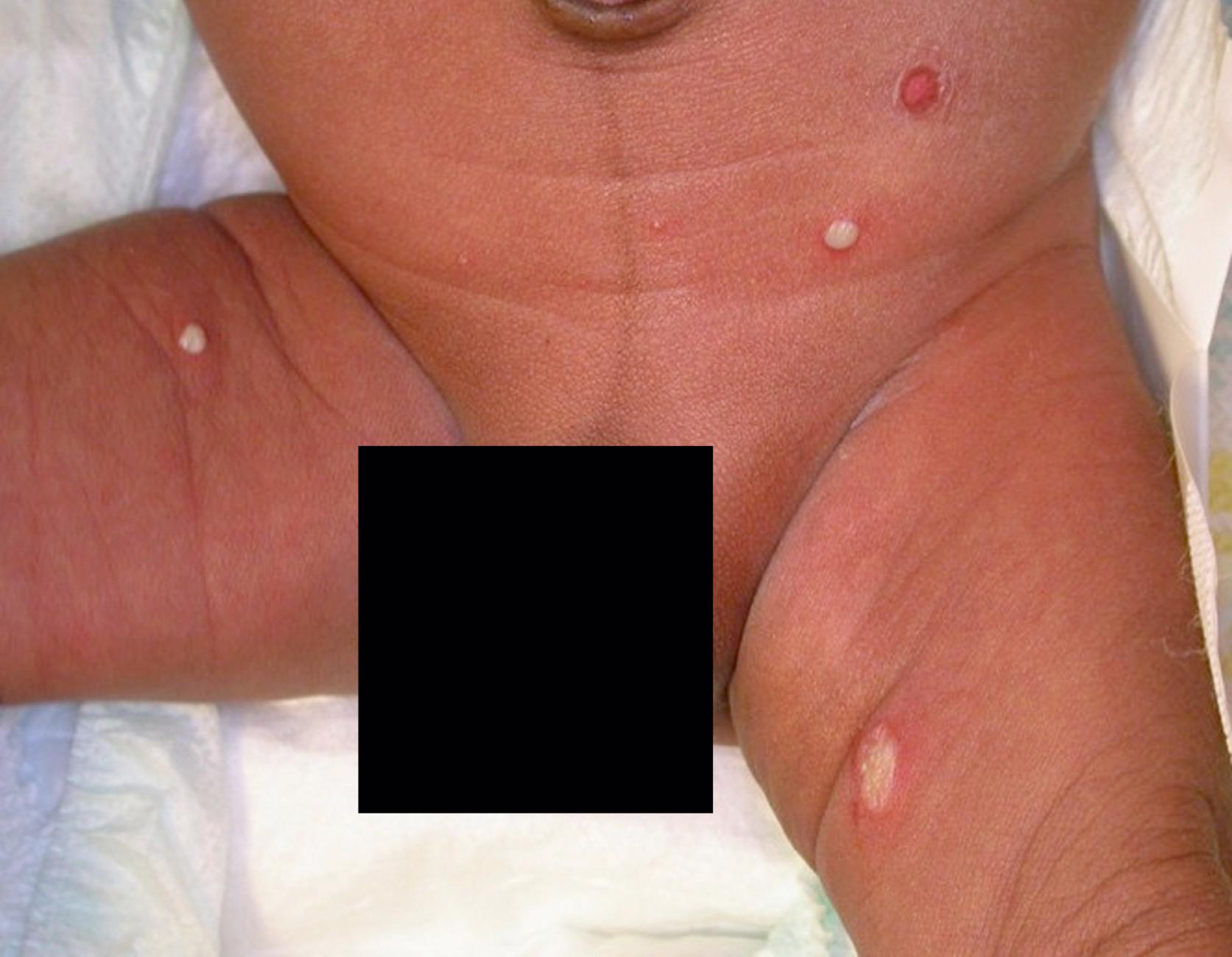
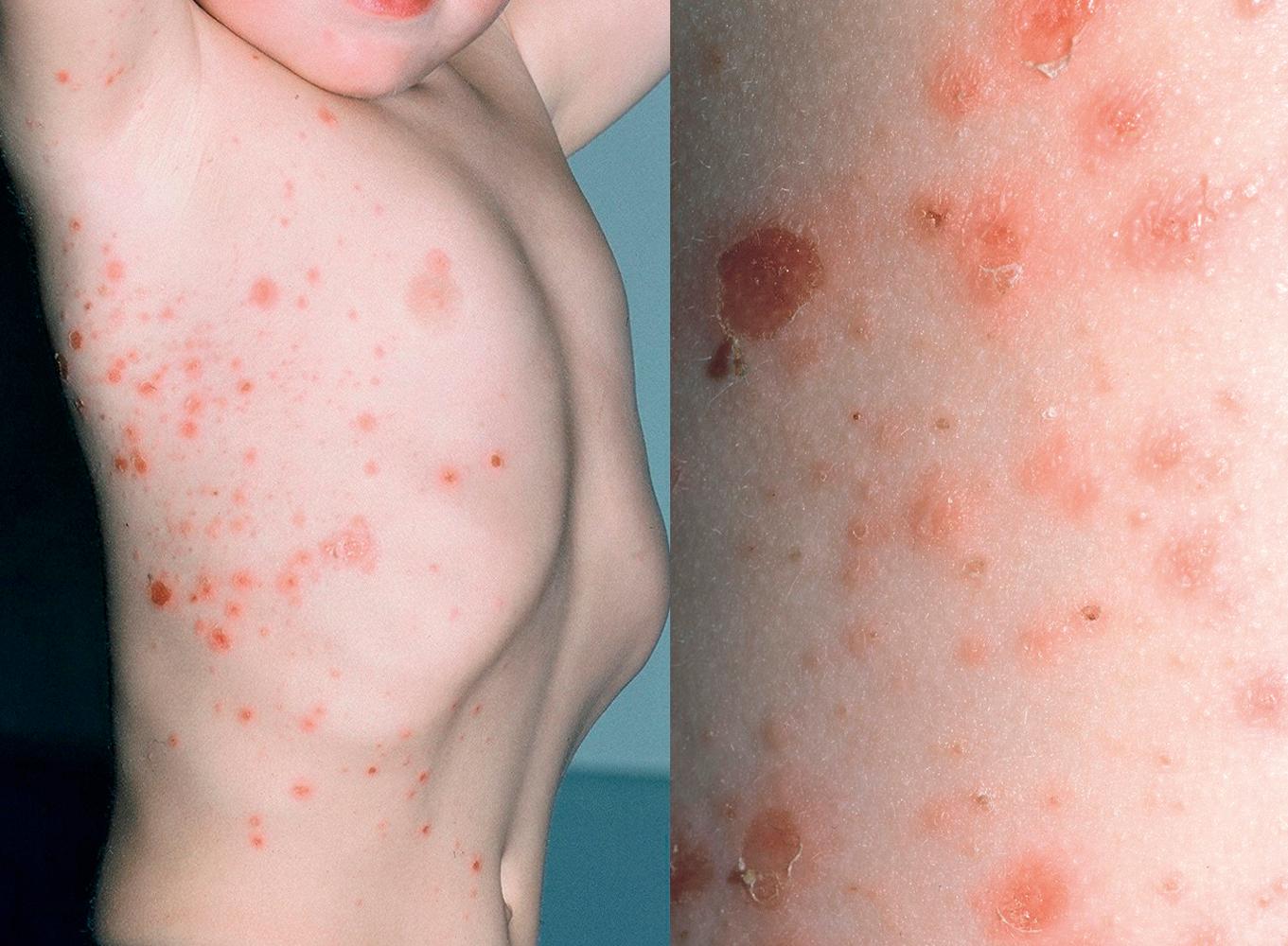
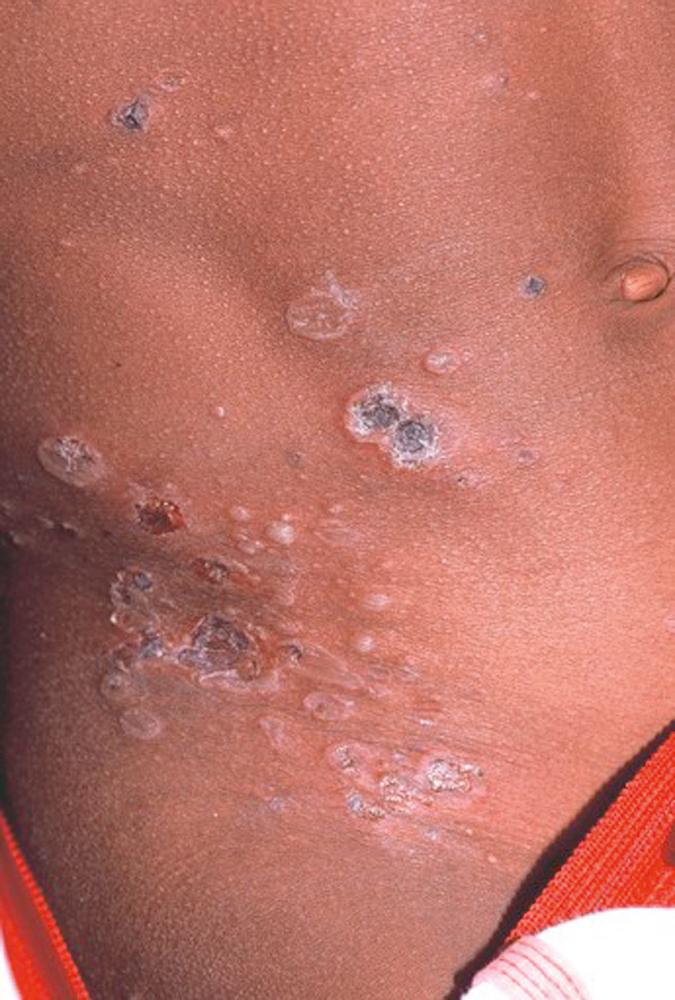
The differential diagnosis of bullous impetigo in the neonate includes transient neonatal pustular melanosis, epidermolysis bullosa, bullous mastocytosis, and neonatal herpes simplex virus infection ( Fig. 67.4 ), the latter of which commonly involves the scalp. Insect bites, contact dermatitis, burns, erythema multiforme, and autoimmune bullous dermatoses must be considered in older children, particularly if the lesions are unresponsive to therapy. Nonaccidental burn injuries can be difficult to distinguish from bullous impetigo. Unlike bullous impetigo, nonaccidental burn injuries may be associated with additional signs of abuse and scalding burns and, specifically, may have characteristic patterns such as symmetric distribution and sharp margins. In children with underlying atopic dermatitis, bullous impetigo needs to be distinguished from other secondary bacterial infection (e.g., due to S. pyogenes ) , as well as secondary viral infections with herpes simplex or coxsackie virus. Eczema herpeticum is an extensive cutaneous eruption caused by herpes simplex virus (HSV) 1 and less commonly by HSV 2 and typically involves areas of skin affected by atopic dermatitis. Unlike bullous impetigo, HSV infection is characterized by vesicles on an erythematous base that evolve into deep, punched out erosions and ulcerations, often with hemorrhagic crusting in areas of skin affected by atopic dermatitis ( Fig. 67.5 ). HSV does not respond to topical or systemic antibacterial therapy; oral antiviral therapy, such as valacyclovir and acyclovir, are the treatments of choice. Eczema coxsackium, which typically is caused by coxsackievirus A6 infection in the setting of atopic dermatitis, may be difficult to distinguish from both bullous impetigo and eczema herpeticum. Eczema coxsackium manifests as widespread vesicles, bullae, and shallow erosions on the torso and extremities within areas affected by atopic dermatitis, such as the skin around the elbows and knees ( Fig. 67.6 ). In contrast to bullous impetigo, this condition does not respond to antibacterial agents and some individuals also may have an enanthem with erosions and vesicles affecting the oral mucosa. ,
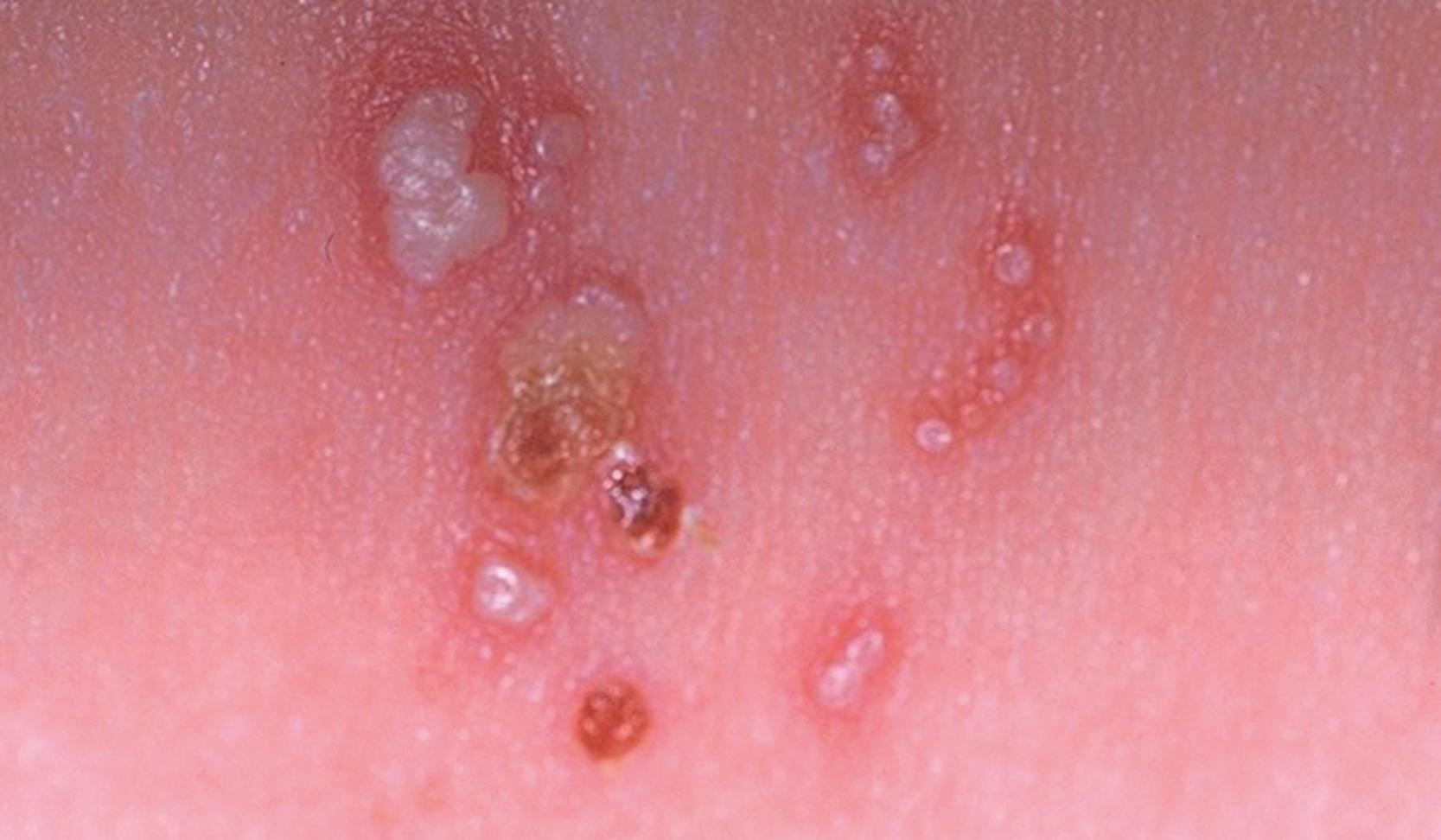
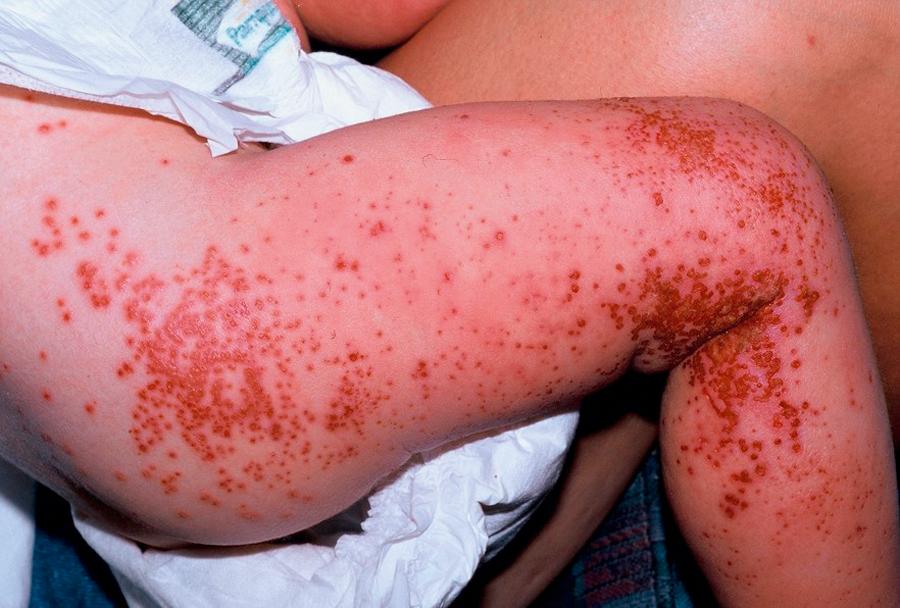
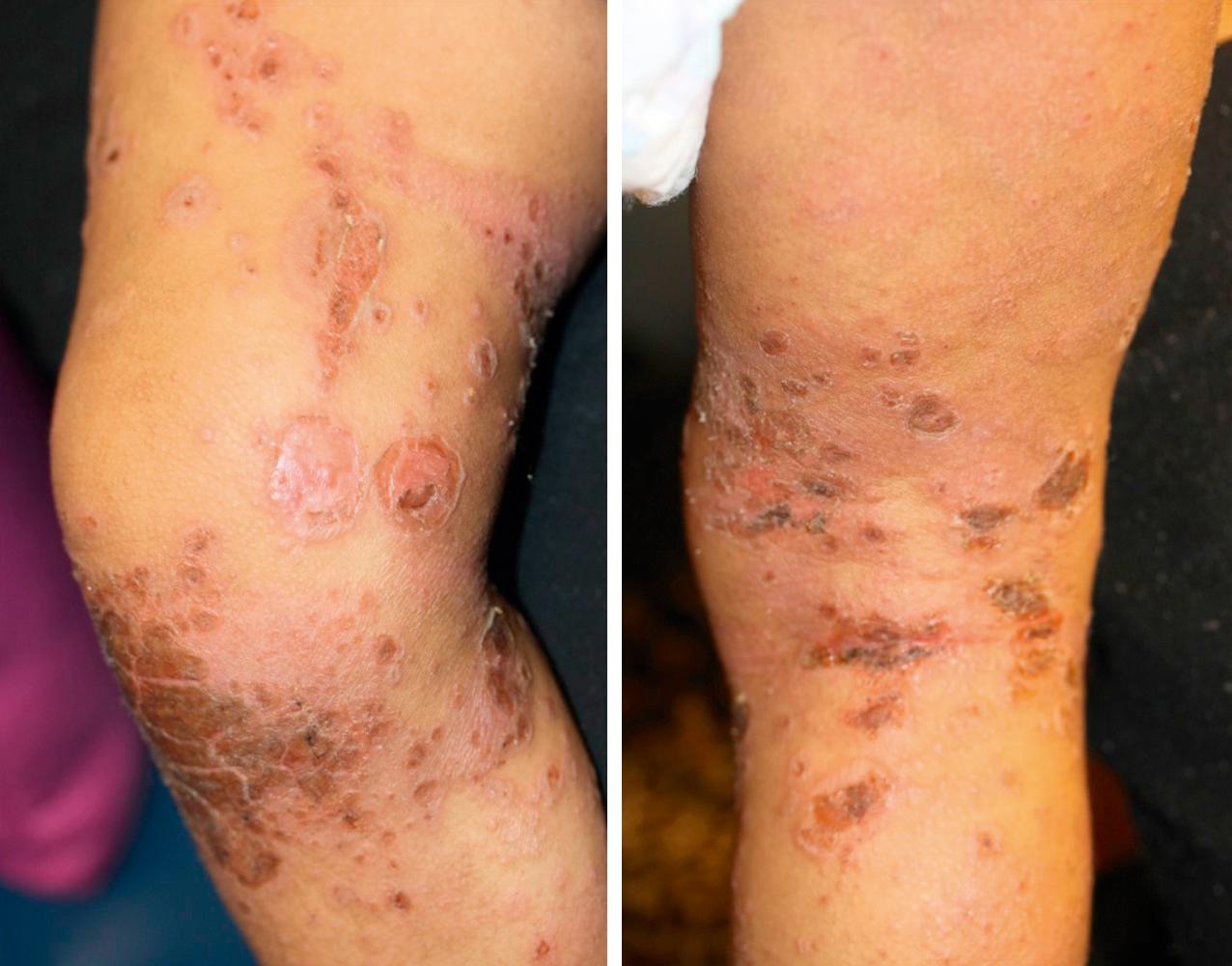
SSSS is a toxin-mediated skin infection most commonly seen in children <5 years of age. SSSS is caused by the release of exfoliative toxins by S. aureus that disseminate hematogenously and result in widespread skin involvement. Exfoliative toxins cleave desmoglein 1, which is responsible for keratinocyte-to-keratinocyte adhesion in the upper epidermis. Tender macular erythema develops, which usually is initially accentuated in the skin folds and subsequently becomes generalized ( Fig. 67.7 ). Superficial desquamation of the fragile skin, sterile blisters, and bullae (due to loss of cell to cell adhesion) are typical ( Fig. 67.8 ). A positive Nikolsky may be seen in SSSS, whereby application of firm pressure to unaffected areas elicits sloughing of the top layers of the skin. Because the blisters occur through hematogenous dissemination of toxin rather than local infection, bacterial cultures of the blisters are negative. , (See also Chapter 115 .)
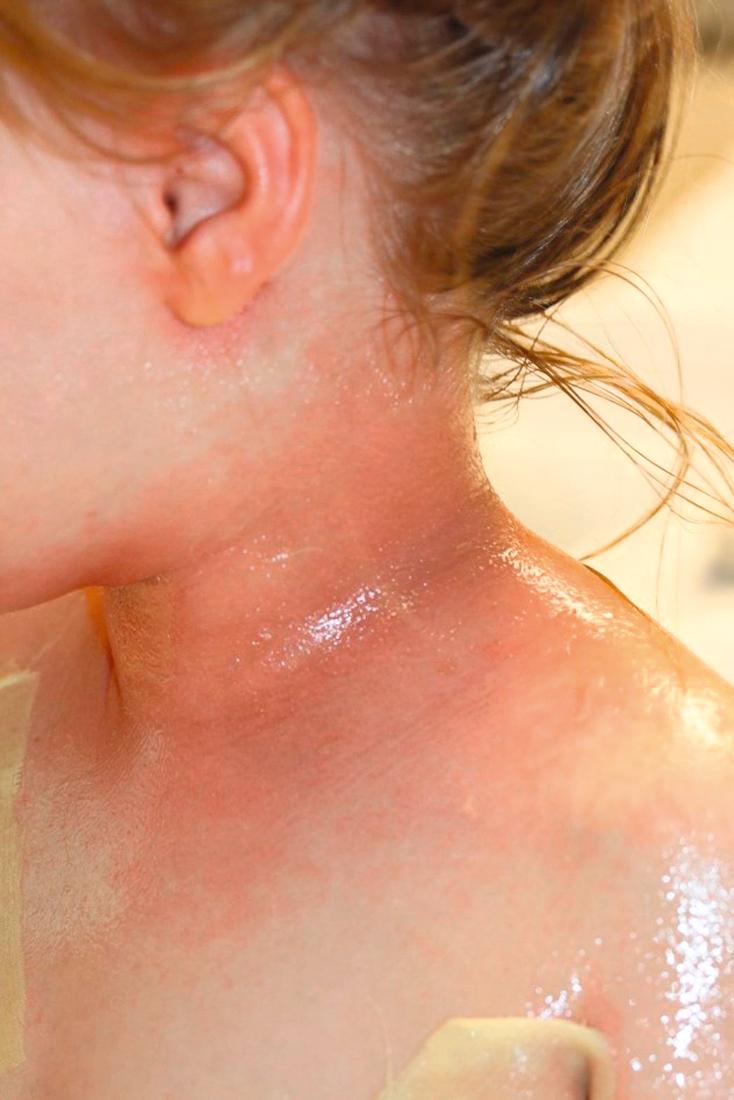
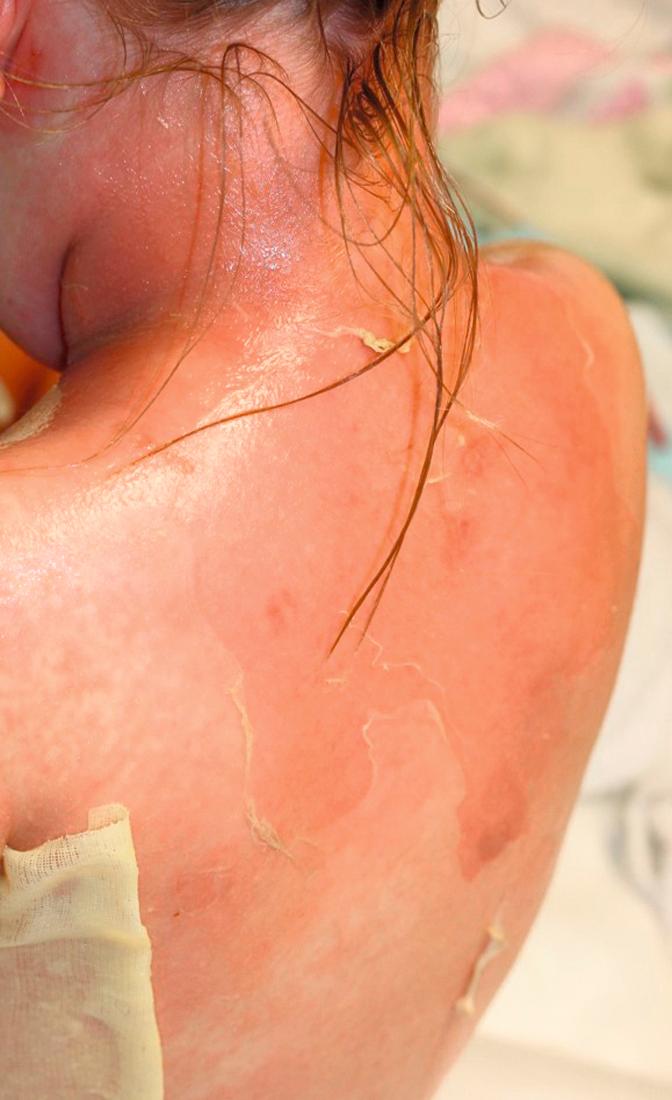
Complications of impetigo are rare and include invasive infections such as pneumonia, osteomyelitis, pyogenic arthritis, and septicemia. Cellulitis can complicate nonbullous impetigo but rarely is associated with the bullous form. Streptococcal impetigo can be followed by lymphangitis, suppurative lymphadenitis, scarlet fever, and acute glomerulonephritis. Acute poststreptococcal glomerulonephritis occurs after skin and pharyngeal infections due to nephritogenic strains of S. pyogenes (i.e., M groups 2, 49, 53, 55, 56, 57, and 60 for epidemics associated with impetigo). Symptoms develop an average of 18 to 21 days after skin infection, and children between the ages of 3 and 7 years are most commonly affected. The anti-DNAase B titer is the best serologic test for detecting preceding streptococcal impetigo as the cause of acute glomerulonephritis. , Current strains of S. pyogenes associated with endemic impetigo in the US rarely have nephritogenic potential, and acute rheumatic fever does not occur as a result of impetigo.
Localized impetigo should be treated with topical antimicrobial agents. Topical mupirocin is as effective as oral erythromycin for the treatment of impetigo, and it may be associated with fewer side effects. , Retapamulin is an effective topical agent for the treatment of impetigo caused by methicillin-susceptible S. aureus (MSSA) and S. pyogenes. , Retapamulin applied to lesions twice daily for 5 days was found to be as effective as oral cephalexin twice daily for 10 days in treating secondarily infected skin lesions. Rates of resistance to topical antibiotics such as mupirocin are increasing, however. More recently, a newer topical nonfluorinated quinolone, ozenoxacin 1% cream, has demonstrated therapeutic efficacy against Staphylococcus and Streptococcus spp. Twice daily application of topical ozenoxacin for 5 days to lesions was found to be significantly more effective than placebo in affected individuals ≥2 months of age.
Systemic therapy is recommended for patients with widespread lesions and for lesions associated with fever or evidence of deeper involvement (e.g., cellulitis, furunculosis, abscess formation, suppurative lymphadenitis). An agent effective against both S. aureus and group A Streptococcus (GAS), such as a first-generation cephalosporin, penicillinase-resistant penicillin, or clindamycin, typically is used when systemic antimicrobial therapy is indicated. , , , Antibiotic selection is based on local resistance patterns of S. aureus . In communities with a high prevalence of methicillin-resistant S. aureus (MRSA), clindamycin, trimethoprim-sulfamethoxazole, and tetracyclines are appropriate choices for systemic therapy. Antibiotic therapy does not prevent acute glomerulonephritis resulting from streptococcal impetigo, but it does decrease the spread of nephritogenic strains to others. ,
Patients with recurrent impetigo sometimes are evaluated for carriage of S. aureus . Focusing on controlling the density of the organism on skin and in the environment and aggressively managing skin conditions may be more beneficial than attempted decolonization. , Decolonization regimens including twice weekly dilute bleach baths, intranasal mupirocin ointment, and chlorhexidine-containing washes have been shown to decrease the occurrence of such infections. , Frequent handwashing and attention to personal hygiene should be emphasized to patients to prevent spread of infection.
Perineal bacterial dermatitis usually occurs in children between the ages of 6 months and 10 years of age and peaks between the ages of 3 and 5 years. The infection is most commonly caused by S. pyogenes , but S. aureus also can cause infection. Physical examination characteristically reveals superficial, well-demarcated, circumferential erythema extending around the anus and surrounding skin ( Fig. 67.9 ). , , Vulvovaginitis with vaginal discharge and vulvar redness is common in girls, as is penile involvement in boys. ,
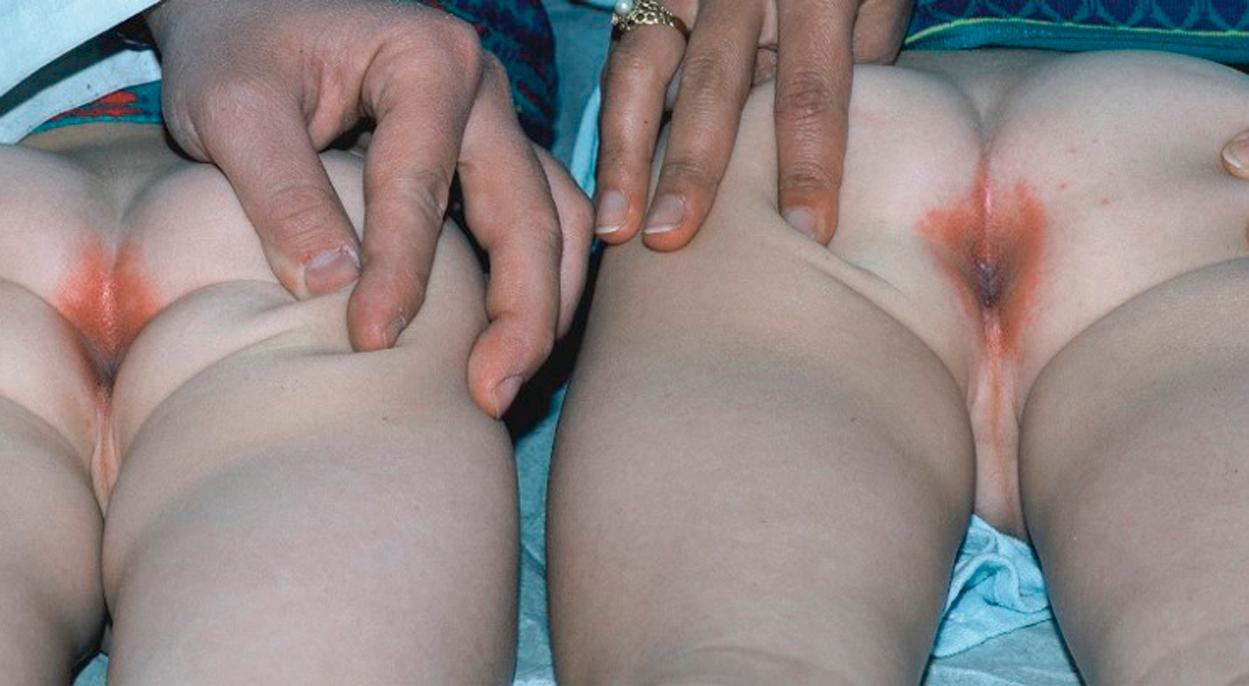
S. aureus is the likely pathogen when small papules and pustules on the buttocks and inguinal area are seen in addition to characteristic perianal findings or when there is extension of erythema onto the buttocks. Additional manifestations include pruritus, painful defecation (sometimes associated with refusal to defecate), blood-streaked stools, fissures, mucoid discharge, and yellow crust. , , , Familial spread of perineal dermatitis is common. , Perianal streptococcal dermatitis is reported to be an infectious trigger for guttate psoriasis, and patients with guttate psoriasis should be examined for asymptomatic S. pyogenes infection.
The differential diagnosis of perineal bacterial dermatitis includes psoriasis, irritant contact dermatitis, candidiasis, and pinworm infestation. Diagnosis often is delayed due to misdiagnosis and lack of awareness of the condition, with patients frequently undergoing treatment with topical antifungal agents or topical corticosteroids before the correct diagnosis is made. , Isolation of S. pyogenes or S. aureus from culture of perianal or vulvovaginal swab specimens confirms the diagnosis.
Therapy should be guided by culture results and susceptibility test results. Penicillin is recommended for cases due to S. pyogenes ; recurrence rates of up to 39% were reported previously, but the rate was only 12% in a recent study. , Clindamycin, a β-lactamase resistant penicillin, or a cephalosporin may be useful in cases due to S. aureus.
Intertrigo is a disorder of the skinfolds resulting from the friction created by opposing skin surfaces combined with a moist environment. Infants are particularly susceptible to intertrigo because they have deep skinfolds, a flexed posture, chubbiness, and a tendency to drool. Secondary infections with Candida albicans, S. pyogenes , S. aureus, and mixed organisms can occur. Bright red, well-demarcated, weeping patches and plaques are seen in the folds of the neck, axillae, antecubital fossa, inguinal area, or popliteal fossae ( Fig. 67.10 ). Satellite lesions suggest Candida infection, whereas streptococcal intertrigo commonly is associated with a foul odor and a fiery red appearance. Affected infants usually appear well but can have associated fever, fussiness, or malaise. ,
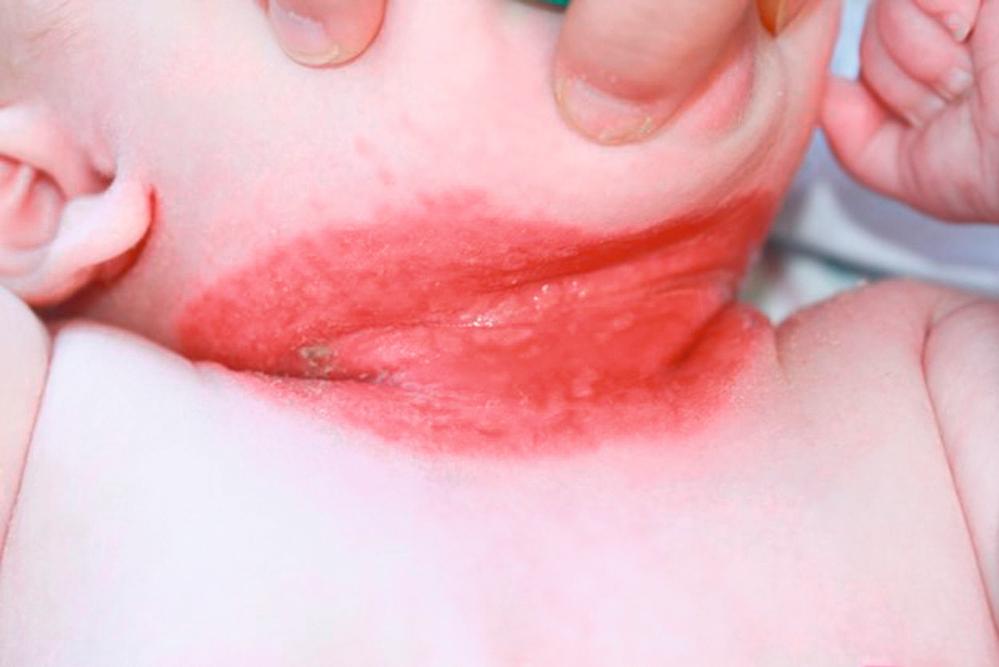
The differential diagnosis of intertriginous dermatitis includes seborrheic dermatitis, atopic dermatitis, irritant or allergic contact dermatitis, erythrasma, inverse psoriasis, scabies, and Langerhans cell histiocytosis. The diagnosis of infectious intertrigo can be confirmed by surface culture from the affected skin.
Treatment of candidal intertrigo consists of topical antifungal agents such as nystatin, econazole, clotrimazole, or ketoconazole, whereas streptococcal intertrigo can be treated with a 10-day course of penicillin or cephalexin in combination with topical mupirocin. Anti-inflammatory agents (e.g., topical 1% hydrocortisone) can be used for associated erythema. Using barrier ointments and ensuring that skinfolds are completely dry can reduce the friction and moisture of intertriginous areas, helping to prevent intertrigo.
Corynebacterium minutissimum is the causative agent of erythrasma. This cutaneous infection manifests as well-demarcated, reddish brown patches and plaques located in moist intertriginous zones. Infections usually occur after puberty. The condition may be asymptomatic or associated with pruritus and involved skin may be thin with a “cigarette paper” quality. Commonly affected sites include the groin, axillae, intergluteal folds, submammary region, and interdigital spaces of the toes. Heat, humidity, obesity, diabetes mellitus, hyperhidrosis, and poor hygiene are predisposing factors. ,
Erythrasma can be confirmed with a Wood lamp examination. C. minutissimum produces porphyrins that fluoresce a brilliant coral-red color under ultraviolet light. However, bathing within 20 hours before the Wood lamp examination can remove the water-soluble porphyrins. When the Wood lamp examination result is negative, a potassium hydroxide examination is useful to exclude dermatophyte infection. Skin scrapings can be stained with periodic acid–Schiff, methenamine silver, or Gram stain to assess for coccobacilli. The differential diagnosis includes candidiasis and inverse psoriasis.
The treatment of choice is erythromycin (250 mg 4 times daily for 2 weeks). Topical clindamycin twice daily or topical erythromycin also can be used. , A single dose of clarithromycin (1 g) is reportedly effective for erythrasma in adults. Recently, monotherapy with mupirocin 2% ointment has shown therapeutic promise in the treatment of erythrasma in adults.
Pitted keratolysis is a skin infection affecting the thick stratum corneum of the plantar surface of the feet and less commonly the palms. Characteristic findings include white, hyperkeratotic areas studded with multiple, 2–4 mm, pitted or erosive lesions on the soles, particularly over pressure-bearing sites ( Fig. 67.11 ). Ringed erythematous lesions that coalesce can be seen on nonhyperkeratotic areas. The condition can be asymptomatic or associated with hyperhidrosis, foul odor due to production of sulfur compounds, pain, and sliminess of the skin. People whose feet are moist for prolonged periods due to hyperhidrosis, immersion in water, or use of occlusive shoes are affected most frequently. Males are affected more often than females. , ,
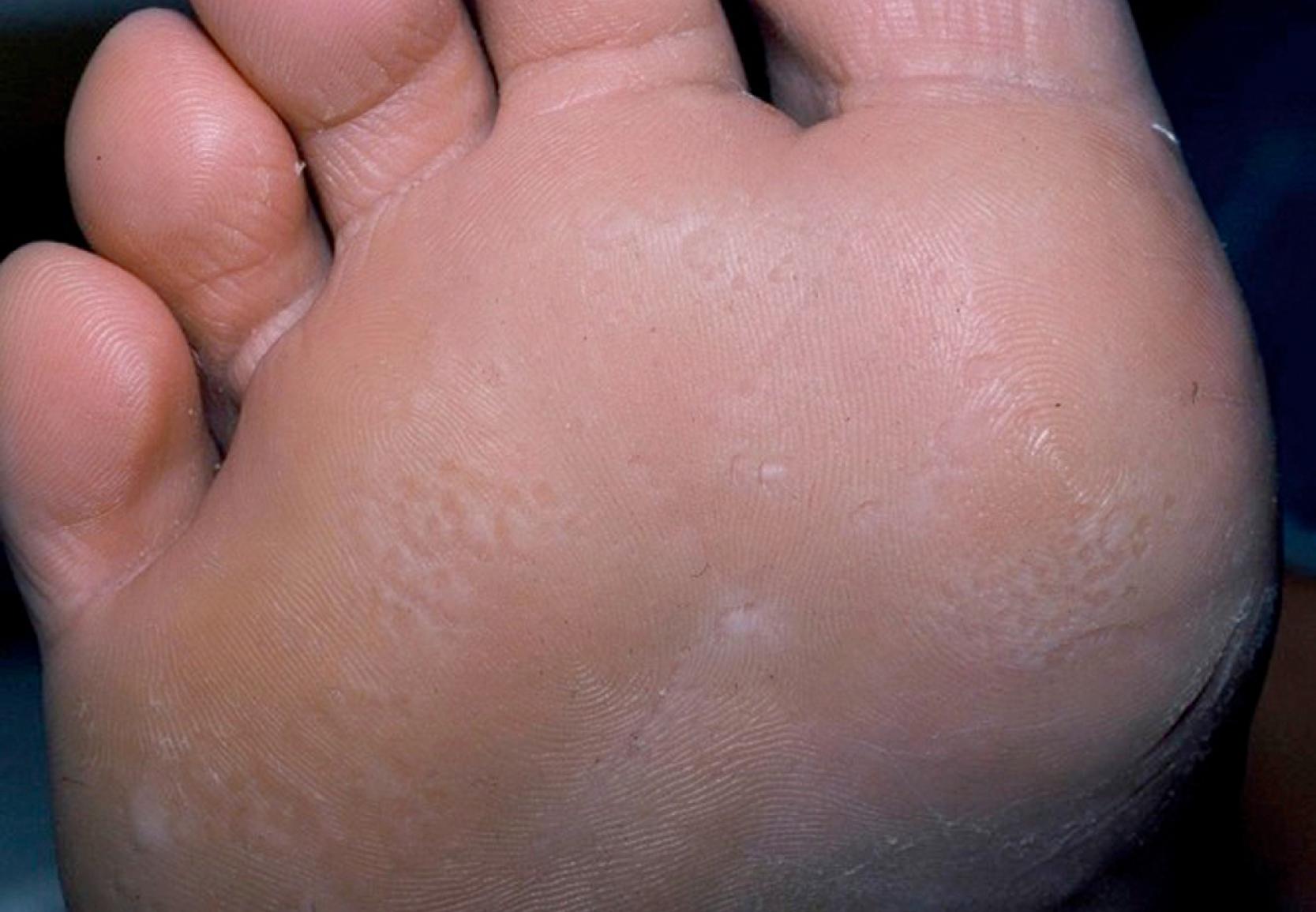
Kytococcus sedentarius (formerly Micrococcus spp.), the suspected causative agent of pitted keratolysis, produces serum proteases capable of degrading keratin in calloused skin. Dermatophilus congolensis and Corynebacterium spp. also have been implicated as pathogens. The diagnosis is based on characteristic clinical findings.
Effective therapeutic regimens include topical therapy for 2–3 weeks with erythromycin, clindamycin, mupirocin, benzoyl peroxide, or fusidic acid. , In a study with 97 patients ages 8–54 years, use of topical erythromycin 3% gel twice daily for ten days resulted in resolution of hyperhidrosis and other clinical features, which may indicate that the hyperhidrosis seen in pitted keratolysis is secondary to bacterial infection–induced eccrine sweat gland dysfunction. However, control of hyperhidrosis with topical aluminum chloride or botulinum toxin, improved hygiene, and use of adequately fitting shoes may also help. ,
Trichobacteriosis (formerly trichomycosis) is an asymptomatic infection of the axillary and less commonly the pubic hair shafts caused by Corynebacterium flavescen s and other coryneform species. , , A bacterial biofilm encases the hair, creating yellow or white concretions distributed along the length of the hair shaft. Hyperhidrosis and a foul odor can be associated with the condition.
The diagnosis is clinical, although a pale-yellow fluorescence may be seen with a Wood light examination. Treatment consists of shaving the affected area, applying topical antibiotics (e.g., clindamycin, erythromycin), and using antiperspirants to control hyperhidrosis.
Become a Clinical Tree membership for Full access and enjoy Unlimited articles
If you are a member. Log in here